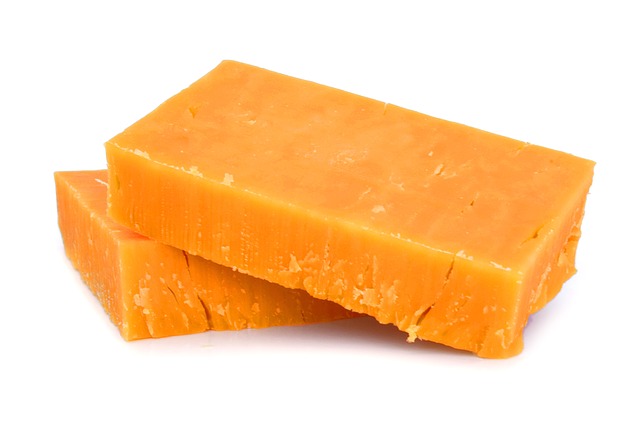By Bob Lipinski
Cheddar, a cheese made from cow’s milk, originated in the sixteenth century near Somerset, England, and is now made worldwide, including in the United States. The first American Cheddar was made not long after the Pilgrims settled in Plymouth. By 1792, cheddar was being exported back to England in large quantities. Most of the early production of cheddar was in Herkimer County, in New York State.
Cheddaring is a term that describes a process used in the making of cheese. A cheese that is “cheddared” has its curd cut into blocks, and these blocks are turned and stacked at the bottom of the tank every ten to 15 minutes for 90 minutes. This process knits the fibers together and squeezes out the whey.
Cheddar can have a white, yellow, or orange (the color is attained with annatto oil) exterior and interior; or the exterior may be covered with black, orange, or even red wax. It comes in various shapes and sizes (cylindrical, rectangular, and wheels).

Cheddar is semisoft to hard with some moisture to the touch; often crumbly when well-aged. A rich, nutty flavor that is sharp and sour with a tang called cheese bite. It becomes more complex and sharper with age.
Depending on the country of origin, cheddar is generally produced in three versions: mild, sharp, and extra sharp. Cheddar is not a name protected cheese and technically can be made anywhere.
Cheddar is similar to Caerphilly, Cheshire, Colby, Dunlop, Lancashire, Leicester, and Wensleydale cheese. Some types and brands of cheddar cheese include Applewood, Black Diamond (Canada), Cornhusker, Cougar Gold, Herkimer, Plymouth, Tillamook, Vermont, and Windsor Red.
Cheddar pairs with apples, cantaloupe, cherries, coconut, honeydew melon, peaches, pears, pineapple, plums, and raspberries. The cheese can be grated and served over eggs, tacos, potatoes, souffles, various sandwiches, grilled tomatoes, and as a topping in some soups.
Some Important Cheddar Dates are:
- 1837: President Andrew Jackson was given a gigantic, 1,400-pound wheel of cheddar cheese by Colonel Thomas Meacham, a dairy farmer from Oswego, New York.
- 1840: Queen Victoria of England (1837-1901) was presented with a giant wheel of cheddar as a wedding gift, from a group of farmers from Somerset. They combined the milk of 750 cows to make a wheel weighing 1,250 pounds.
- 1894: Tillamook Cheddar was first made in Tillamook, Oregon.
- 1930: Cold pack cheese was created by Hubert Fassbender of Wisconsin, as a convenient spread to utilize odd and surplus lots of cheese, especially cheddar.
- 1964: The Wisconsin Cheese Foundation’s cheesemaker, Steve Siudzinski, made a block of cheddar cheese using 170,000 quarts of milk that weighed 34,951 pounds and was 14 feet across. The cheese was driven from Wisconsin to New York to be part of the World’s Fair.
- 1989: The Oregon Federation of American Cheesemakers created the largest cheddar cheese weighing 56,850-pounds.
Some recommended white wines to enjoy with a wedge of cheddar include Chardonnay, dry Riesling, Sauvignon Blanc, or a white Rioja. For lovers of red wines, grab a bottle of Cabernet Franc, Chianti, Merlot, Pinot Noir, a red Rioja, or a Zinfandel from Lodi, California. Beyond that, try a dry marsala, dry sherry, white port, or beer… a bottle of porter, stout, or your favorite pale ale.
If you enjoy spirits, a glass of Laird’s Applejack, Scotch, bourbon, Tennessee whiskey, or even dark rum pairs well. Personally, I like a wedge of cheddar with a glass of a chilled French Sauternes or dry Marsala (from Italy).
Bob Lipinski is the author of 10 books, including “101: Everything You Need To Know About Whiskey” and “Italian Wine & Cheese Made Simple” (available on Amazon.com). He conducts training seminars on Wine, Spirits, and Food and is available for speaking engagements. He can be reached at www.boblipinski.com OR bkjm@hotmail.com


 Bob Lipinski, author of 10 books; writes, consults, and conducts training seminars on Wine, Spirits, and Food and is available for speaking engagements.
Bob Lipinski, author of 10 books; writes, consults, and conducts training seminars on Wine, Spirits, and Food and is available for speaking engagements.
Recent Comments